
The great French composer Olivier Eugene Prosper Charles Messiaen was born in Avignon on December 10, 1908. He was the first son of extraordinary parents: Cecile Sauvage, his mother, was a poet of note, and his father, Pierre Messiaen, was an English teacher who translated Shakespeare's plays into French. At the precocious age of eleven Olivier entered the Paris Conservatory, where he studied with Paul Dukas, Charles-Marie Widor, and Marcel Dupree, a famed composer and two famous organists -- and, most crucially, Maurice Emmanuel, who though not as well known as the above-named would prove to have arguably the greatest influence on Messiaen's music through Emmanuel's interests in birdsong and scales and rhythms of other cultures, notably India and ancient Greece. By age 22 he had a prestigious organist post (which he kept for the rest of his life) and had already written a masterpiece. He went on to become "the most influential European musician of the second half of the twentieth century" (David Schiff, The Nation), and even if, despite assuming the unstated "classical" between "European" and "musician," that is perhaps an exaggeration, he inarguably was a revered teacher whose concepts of rhythm and structure influenced nearly all the post-war Serialists either directly (many of them were his students, most famously Pierre Boulez) or indirectly, specifically his extension of the concept of serial music past pitch into rhythm, duration, dynamics, and more (Messiaen never wrote any 12-tone music).
One of the concepts that made his music so distinctive is "modes of limited transposition." He used scales that, after a certain number of chromatic transpositions varying with each mode, are no longer transposable because one is repeating previous versions enharmonically. (The simplest example is that workhorse of Impressionism, the whole-tone scale, which has just two versions.) This meant that he was not working with the cadence-oriented diatonic harmonies of most music, which combined with his love of retrograde rhythms to give his compositions a sense of existing outside time. Furthermore, he emphasized color (timbre) as much as any composer ever did, and created shimmering sounds reflecting his personal sound-color synaesthesia. Finally, his devout and mystical Roman Catholicism strongly dictated his subject matter. Here are ten albums encapsulating his greatness. 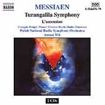
Turangalîla-Symphonie; L'ascension Francois Weigel, piano; Thomas Bloch, ondes Martenot; Polish National Radio Symphony Orchestra; Antoni Wit, conductor (Naxos)
This epic work, in 10 movements, has to be the most eccentric symphony ever to top the ten-recording mark. It was written in the years following World War II on a remarkably open commission from the Boston Symphony Orchestra and its conductor Serge Koussevitzky (who said, "Write me the work you want to, in the style you want, as long as you want, with the instrumental formation you want") and premiered under Leonard Bernstein in 1949. The title is Sanskrit, very approximately meaning "game of love" though also denoting a rhythmic pattern in ancient Hindu music, but its inspiration is the Tristan and Isolde legend of transcendent love. (Transcendent yet forbidden, something Messiaen learned about first-hand; his first wife, violinist Claire Delbos, was tragically suffering from a degenerative brain disease that affected her memory and eventually left her an institutionalized invalid, and he fell in love with his student Yvonne Loriad, who became his second wife after Claire died.) Despite its worldwide ingredients, it is prototypically French, utilizing the cyclical structure beloved of 20th century French symphonists and emphasizing orchestral color. The movements are: 1. Introduction 2. Chant d'amour [Song of Love ] 3. Turangalîla I 4. Chant d'amour II 5. Joie du sang des Atoiles [Joy in the Blood of the Stars] 6. Jardin du sommeil d'amour [The Garden of Love's Slumber] 7. Turangalîla II 8. Developpement de l'amour [The Growth of love] 9. Turangalîla III 10. Final The orchestra is larger than usual, well over a hundred, with several unusual additions It has a prominent piano part of considerable difficulty, as well as lesser roles for celeste and keyboard glockenspiel, and also features an odd early electronic instrument (invented in 1928), the ondes Martenot, somewhat like a theremin in tone but capable of more control and variety. The piano part was originally played by Yvonne Loriod; eventually her sister, Jeanne, played the ondes Martenot. The latter instrument's large, sweeping glissandi stand out the most, but it also doubles treble instruments' parts at times, reinforcing the orchestral textures at climaxes, of which there are many. There are four main themes that pop up in multiple movements; Messiaen later gave these themes names. They are not just melodies but harmonic passages. The "statue theme" first uses monolithic brass chords in the lower register; the "flower theme" is introduced by two clarinets; the long "love theme" is ardently intense; finally, there is a "chain of chords." (There are many lesser themes as well.) The frequent reappearances of the main themes in shifting contexts ties the massive work together, while Messiaen's imaginative orchestration varies timbre density and colors keep the listener stimulated rather than dulled by these repetitions. The effect is otherworldly yet vibrantly sensual, and -- as compared with his religious-themed works -- a good deal more rhythmically lively overall. Though this 1998 recording is a two-CD set and there are one-disc versions, Naxos is a budget label, so this doesn't cost more. This set also carries the benefit of using Messiaen's 1990 revision. And Wit brings as much emotional breadth, as much scintillation, and as thrilling an orchestral sound to this masterpiece as more famous conductors, along with considerably more fidelity to the score's finer details and a complete understanding of how important profound breadth of tempo can be to producing this music's maximum impact. In comparison to Turangalîla, the much earlier L'ascension (1933) may seem pallid and dry, but it was Messiaen's first orchestral success and was much played. Think of it here as a bonus offering an interesting contrast. 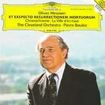
Et Exspecto Resurrectionem Mortuorum; Chronochromie; La Ville d'en haut Cleveland Orchestra; Pierre Boulez, conductor (Deutsche Grammophon)
This 1993 recording brings together three performances led by the composer's most famous student. Chronochromie (1960) seems utterly abstract in its Greek-play-derived structure (Introduction - Strophe I - Antistrophe I - Strophe II - Antistrophe II - Epode - Coda) and serialized treatment of note durations, but despite being percussion-heavy at times this piece relies very strongly on birdsongs (sometimes on xylophone, marimba, and glockenspiel) and depictions of natural elements (rocks, water). La Ville d'en haut [The City on High], i.e. Heaven, is a 1987 piece in one movement for woodwinds, brass, piano, and percussion, including tuned percussion. The contrasts between block chords by brass and the tintinnabulation of the percussion is delightful. Et Exspecto Resurrectionem Mortuorum (1964), the crucial work here, is also for winds, brass, and percussion, but on a larger scale of five movements, each equipped with a title take from Scripture. It opens ominously for "Out of the depths have I cried unto thee, O Lord," with dissonant chords truly crying out. "Christ being raised from the dead dieth no more; death hath no more dominion over him" brings quiet comfort from woodwind melodies in a mood half pastoral, half meditative, with brass and percussion occasionally interjecting an odd chorale in a traditional Indian rhythm. "The hour is coming when the dead shall hear the voice of the Son of God" mixes an Amazonian birdsong, chimes suggestive of time, and a series of crescendos. "It will be raised in glory, with a new name -- with the morning stars singing together, and all the sons of God shouting for joy" is an effervescent movement that undulates, chirps, and chimes in celebration, sounding quite ritualistic and including some chant quotations. Finally, "And I heard as it were the voice of a great multitude" combines the chants and first-movement melody with mystical gongs and a lengthy grand chorale of slow-moving chords over a gong pulse. 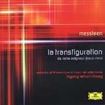
La Transfiguration de Notre-Seigneur Jesus-Christ Roger Muraaro, piano; Thomas Prevost, flute; Robert Fontaine, clarinet; Eric Leviannois, cello; Francis Petit, marimba; Renaud Mussolini, xylophone; Emmanuel Curt, vibraphone; Radio France Choir & Philharmonic Orchestra; Myung-Whun Chung, conductor (Deutsche Grammophon)
A massive work for mixed choir, seven instrumental soloists, and "very large orchestra," The Transfiguration of Our Lord Jesus Christ took almost four full years to compose (1965-69). Of its content, Messiaen wrote, "Various aspects of the Mystery of the Transfiguration of Christ are presented one after the other by a mosaic made up of Latin texts" taken primarily from the Gospels, then from other parts of Scripture (Genesis, Psalms, the Wisdom of Solomon, the Epistles of Paul), finally from the missal and the Summa theological by St. Thomas Aquinas." The first text is Matthew 17/1-2, dealing with the event of the work's title: "And after six days Jesus taketh Peter, James, and John his brother, and bringeth them up into an high mountain apart. And was transfigured before them: and his face did shine as the sun, and his raiment was white as the light." In the following verses, which show up as the fourth and eighth parts of Messiaen's 14-section work, Moses and Elias appear and speak with Jesus, and then "a bright cloud overshadowed them: and behold a voice out of the cloud, which said: This is my beloved Son, in whom I am well pleased; hear ye him." This combination of nature (the mountain) and brilliant light, not to mention inexplicable religious mystery, fits into many of Messiaen's preoccupations and thus provides fine inspiration for him. The musical emphasis is often on the orchestra more than the chorus, and the vast instrumentation enables Messiaen to create some extremely colorful moments. There's a great deal of percussion, especially in the first movements of parts one and two; the tuned gongs and tam-tams lend a strong Balinese gamelan flavor. This mighty work does not at any point offer the sort of sweetly mellifluous crooning associated with so much religious choral music; the appearance of God in the eighth movement contains some amazingly stark dissonances, huge clashing chords clearly meant to evoke the terror Jesus' disciples must have felt in the face of divine pronouncement. A few of Chung's DG Messiaen recordings have suffered from muddy acoustics and mushy conducting, but certainly this 2001 two-CD set avoids both. Chung contrasts movements dramatically, playing up the ritualistic aspect of the severe choral lines but moving with relative briskness elsewhere. The Philharmonic Orchestra of French Radio plays brilliantly; the only complaint is that men of the Choir of Radio France sometimes sound a bit distant, especially in comparison to the close clarity of the brass and percussion, but that's actually a realistic perspective (the mental adjustment experienced listeners make in a concert hall, where the orchestra would of course be seated in front of the choir, is less effective when listening to the flatter sound of a recording, where a choir's presence always seems diminished unless the microphones help unnaturally). The majesty and splendor of this large work, seconds short of 100 minutes in this recording, is convincingly conveyed. 
Éclairs sur l'au-delà … Polish National Radio Orchestra, Katowice; Antoni Wit, conductor (Jade)
This 1993 concert recording is no longer in print on CD, but remains available via iTunes. It was the first recording released of the last piece Messiaen finished. Éclairs sur l'au-delé [Illuminations (or, Lightning flashes) of the beyond"] is for a large orchestra with a considerable amount of percussion, but rarely are all that many people playing at once. It is hauntingly stark. Over an hour in length, it has eleven movements: 1. "Apparition du Christ glorieux" [Vision of Christ Glorified] 2. "La constellation du Sagittaire" [The Constellation of Sagitarius] 3. "L'Oiseau-lyre et la Ville-Fiancée" [The lyre bird and the bridal city] 4. "Les élus marqués du scaeu" [The elect marked with the seal] 5. "Demeurer dans l'Amour" [Abide in love] 6. "Les sept anges aux sept trompettes" [The seven angels with the seven trumpets] 7. "Et Dieu essuiera toute larme de leurs yeux" [And God will wipe away all the tears from their eyes . . .] 8. "Les étoiles et la Gloire" [The stars and the glory] 9. "Plusiers oiseaux des arbres de la Vie" [More birds than there are living trees] 10. "Le chemin de l'invisible" [The way of the invisible] 11. "Le Christ, lumiere du Paradis" [Christ, light of paradise] This is a work of truly unearthly beauty, and a fine valedictory note for Messiaen to leave on. 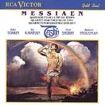
Quatour pour la fin du temps Tashi: Peter Serkin, piano; Ida Kavafian, violin; Fred Sherry, cello; Richard Stoltzman, clarinet (RCA Victor Gold Seal) Quartet for the End of Time has as legendary a genesis as any piece of its century. Working behind the lines as a medical auxiliary (his eyesight being too bad for him to serve as a soldier), Messiaen was captured at Verdun and imprisoned by the Germans, but had a sympathetic jailer who provided him with materials for composing. His fellow prisoners included a violinist, a cellist, and a clarinetist, and he composed pieces for them. Eventually these were collected as a quartet adding the composer on piano, but -- unusual in quartet literature -- not all the musicians play in any given movement, and one is even for solo clarinet. The premiere took place in the prison camp before five thousand fellow prisoners plus guards. Messiaen later declared, "Never was I listened to with such rapt attention and comprehension." He dedicated the piece "In homage to the Angel of the Apocalypse, who raises his hand towards Heaven saying: 'There shall be no more time'." The opening movement, "Liturgie de cristal" [Liturgy of Crystal], is for full quartet. The clarinet begins solo, playing the song of the blackbird; the piano joins; then the violin impersonates a nightingale. The cello plays a 15-note melody of just five pitches repeatedly in a high, silvery tone. "Vocalise pour l'ange qui annonce la fin du temps" [Vocalise for the Angel who announces the end of Time] opens sternly, depicting the powerful angel briefly, followed by a stately melody under which the piano plays chords in an absolutely regular beat, but with accents varying the rhythmic feeling. The angel returns briefly to end the movement. The extremely slow "Abîme des oiseaux" [The abyss of the birds] is for solo clarinet. Messiaen stated, "The abyss is Time with its sadness, its weariness. The birds are the opposite to Time; they are our desire for light, for stars, for rainbows, and for jubilant songs." The abyss depiction seems very simple, but the slow tempo and extended durations make it a hard test of the player's breath control; the twittering of birds interrupts at times. At over seven minutes, at times hovering near the edge of inaudibility, it nonetheless holds listeners rapt. Violin and cello rejoin, but the piano is omitted, for "Intermède" [Interlude], a scherzo that offers a distinct contrast. "Louange à l'éternité de Jésus" [Praise to the eternity of Jesus] is a cello/piano duo of unutterable beauty, the cello spinning out a long, sustained melody with the piano sometimes chiming quiet repeated chords underneath (there is one big crescendo two-thirds in). "Danse de la fureur, pour les sept trompettes" [Dance of fury, for the seven trumpets] returns to quartet format, depicting the Apocalypse, its stages announced by trumpets and gongs imitated by the quartet, which plays in unison for the entire movement as Messiaen varies the rhythm unceasingly and puts the thematic material through vigorous paces. "Fouillis d'arcs-en-ciel, pour l'ange qui annonce la fin du temps" [Cluster of rainbows, for the Angel who announces the end of Time] reuses some material from the second movement, but the angel is depicted even more powerfully this time. Similar in construction to the earlier duo, the slow, ethereal violin/piano duo "Louange à immortalité de Jésus" [Praise to the immortality of Jesus], adapted from the organ work "Diptyque," closes the piece with a depiction of Jesus' ascent to Heaven as he moves from flesh-and-blood man to reunite with God. It is worth looking for Messiaen's 1956 mono recording of this piece (with Jean Pasquier, original cellist étienne Pasquier, and André Vacellier), now on import on Accord. But for over three decades, Tashi's 1975 recording has been the best, and since it's just $10, the choice is obvious. In fact, Tashi formed specifically to play this piece. 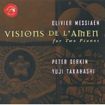
Visions de l'Amen; Catalogue d'oiseaux VII: La rousserolle efarvatte Peter Serkin, Yuji Takahashi, pianos (RCA Victor)
From 1943, Visions de l'Amen is for two pianos and explores seven different meanings of "amen" -- or states of being to which "amen" applies: "Amen of the Creation," "Amen of the Stars, of the Ringed Planet," "Amen of the Agony of Jesus," "Amen of Desire," "Amen of the Angels, Saints, and Birdsong," "Amen of the Judgement," and "Amen of the Consummation." Since these are abstract moods viewed contemplatively rather than "in the moment," there is often a feeling of vast objectivity, as of situations viewed across space and tinged with icy grandeur. In order to keep the two-piano texture from being muddy, Messiaen often puts the pianists in contrasting registers; the frequent upper-register figures accentuate the icy character. Proceeding slightly more slowly overall than, for instance, the duo Double Edge on New Albion (with no filler) and the composer-approved Erato recording with Katia and Marielle Labèque, Serkin and Takahashi coordinate well in music which sometimes cuts loose from rhythmic bearings. Serkin distinguishes himself even more in the generous filler, La rousserolle efarvatte, a 28-minute movement from Messiaen's massive birdsong-inspired solo piano cycle Catalogue d'oiseaux. "La rousserolle efarvatte" is primarily based on the reed warbler, but the bird's entire habitat is depicted as most characteristic at various times of the day. 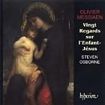
Vingt Regards sur l'Enfant-Jésus Steven Osborne, piano (Hyperion)
When Messiaen wrote Vingt Regards sur l'Enfant-Jésus [Twenty View of the Infant Jesus] in 1944 in Nazi-occupied Paris, it was his largest-scale piano work by a wide margin (20 movements lasting over two hours total). It was also hugely controversial, with some critics finding its rhythmic structures and motivic repetitions irritating, its Lisztian pianistic virtuosity and emotional violence unsuited to its religious theme, and Messiaen's commentary ill-advised. In the decades, since, however, it has come to be seen as a milestone of 20th century piano music. The recording by Yvonne Loriod, who premiered it (and later married Messiaen), long set the standard. In recent years there has been a spate of excellent new recordings: the dazzlingly virtuoso (but, to some tastes, rushed) Pierre-Laurent Aimard, an intelligent but short-lived set by Messiaen scholar Peter Hill, and a reflective, budget-priced set from Hakon Austbo. Though costing more than any of the others, this 2001 recording is the one to get, however. Osborne studied Vingt Regards with Loriod at her invitation, and his performance partakes somewhat of the subtle character of her own without slighting the required vehemence in many moments. His command of a wide range of dynamics and tonal colors sets him apart from much of the competition, and Hyperion's top-notch recorded sound conveys it all with both clarity and presence. Osborne's keen understanding of Messiaen's rhythmic language, and the importance of silence and patience, also contributes greatly to this characterful reading. This is a difficult work, gorgeous in some sections (such as No. 15, "The Kiss of the Infant Jesus") but more often almost violent in its emotions, and usually thickly textured and complexly written. Osborne makes it as communicative as anyone yet has, without reducing its implications. 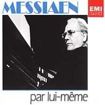
Le banquet céleste; Diptyque (Essai sur la vie terrestre et l'éternité); Apparition de l'Église éternelle; L'Acension (4 Meditations); La Nativité du Seigneur (9 Méditations); Les Corps glorieux (7 Visions de la vie des ressuscités); Messe de la Pentecôte; Livre d'orgue (7 piéces) Olivier Messiaen, organ (EMI France)
Messiaen was the only top-tier composer of the 20th century to leave a significant body of organ music revered by a larger constituency than just organ buffs. In 1956, he recorded all of his published organ works to that time (he later wrote more, not included here) on the organ that many of them were written to be played on, the 1869 instrument built by Aristide Cavaillé-Coll in the Church of the Holy Trinity in Paris. Messiaen became the organist there in 1931 and three years later oversaw a renovation of the organ that included the addition of new stops he had suggested. With every great organ sounding different not only by virtue of its stops but also its acoustical environment, the importance of hearing Messiaen's post-1930 pieces played on this particular instrument is undeniable, making this four-CD set a must-have item. It is impossible to listen to these pieces and not think how the great French organ tradition influenced the sound of his orchestral works (on the other hand, Cavaillé-Coll organs are highly symphonic). "Le banquet céleste" (1926) is Messiaen's earliest masterpiece, and already finds him using modes of limited transposition. The piece's performance indication is "Very slow, ecstatic," and the music's subject is Holy Communion. As the music oscillates between two rich, long-held chords, intermittent short notes, higher in pitch, are overlaid. "Diptyque (Essai sur la vie terrestre et l'eternité essay on life on earth and eternity] (1930) contrasts the "fruitless agitation" of life with the sublimity of Paradise. The same theme is used for both of the piece's movements; the restlessness of the minor-key first movement is extraordinary; in the second, we are in major and the theme moves very slowly. "Apparition de l'Église éternelle" Apparition of the Eternal Church] (1932) is a long crescendo of increasing layers of sound followed by a mirroring decrescendo, with a single rhythmic figure throughout (varied in length). L'Acension [Ascension Day] (1933) is an organ version of an orchestral piece consisting of four movements/meditations. Messiaen considered the third movement to be untranscribable for organ, and wrote an entirely new movement instead: "Transports de joie d'un âme devant la gloire du Christ qui est la sienne" [Outburst of joy from a soul before the glory of Christ which is its own glory], which unlike the serenity of the rest of the work is an exuberantly virtuoso showpiece of sparkling colors. Messiaen's best-known organ work, La Nativite du Seigneur [The Nativity of the Savior] (9 Meditations) (1935) is an hour-long cycle the composer called "many-colored, like the stained-glass windows of medieval cathedrals." He also noted, "The pedal forsakes its usual bass role," and much of this piece wafts high in the air, a sonic aurora. Some of Messiaen's most memorable themes are heard, but even the busiest of them seem to spiral rather than conveying forward motion. Les Corps glorieux (Sept Visions de la vie des ressuscites) [The Glorious Bodies: Seven Brief Visions of the Life of the Resurrected] (1939) consists of "The Refinement of the Glorious Bodies," "The Waters of Grace," "The Angel Surrounded by Perfumes," "Battle between Life and Death," "The Strength and Agility of the Glorious Bodies," "The Joy and Revelation/Enlightenment of the Glorious Bodies," and "The Mystery of the Holy Trinity." Messe de la Pentecôte [Mass of the Pentecost] (1950) consists of five pieces timed for the organ's function in the structure of the low mass: entry, offertory, consecration, communion, exit. Among its interesting aspects are the first movement's inventory of Greek metrical feet, including five-beat and seven-beat rhythms; the offertory's mixture of liturgical chant and birdsong plus the gloriously deep and penetrating bottom C of the bassoon 16' stop; more birdsongs in succeeding movements; and the conclusion of the communion on the most extremely separate sounds the organ has, sub-bass 32' and piccolo 1'. Livre d'orgue [Organ Works] (1952) consists of seven pieces and is rhythmically daring thanks to Messiaen's use of Indian patterns and retrograding. Messiaen rarely wrote truly abstract organ music; the first and last pieces of this cycle are the only examples, "Reprises par interversion" with its wide leaps over starkly bare spaces, "Soixante-quatre durees" [64 durations] with its chromatic durations, wherein distinct durations are assigned to 64 pitches -- the sort of technique that fascinated the serialists. And though the intervening pieces have titles describing their topics, without knowing them one might assume them to be abstract as well with their seemingly mathematical contours eliminating most traces of melody. And yet, when he premiered the cycle in 1955, there was a massive crush to get into the church. The performances by the composer are nearly definitive, but tuning problems with some reed stops (it had been twenty years since the previous overhaul of the instrument) and the mono sound slightly flaw the recording, and of course there are many later works not here so fans will want additional performances in modern sound. Olivier Latry's six-CD set of the complete organ works on Deutsche Grammophon, using the Cavaillé-Coll at Notre Dame, solves all these problems and is highly recommendable.
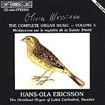 Meditations sur le mystere de la Sainte Trinity Hans-Ola Ericsson, organ (BIS)
Meditations sur le mystere de la Sainte Trinity Hans-Ola Ericsson, organ (BIS)
I would rather recommend Messiaen's own 1972 recording of this piece on Erato, but right now it's only available in the Warner Classics 18-CD box set Messiaen Edition. Look for a used copy of an earlier edition, where it's in a two-disc set with the orchestral work Trois Petites Liturgies de la Presence Divine (a 1964 recording with Yvonne Loriod, piano; Jeanne Loriod, ondes martenot; Choir of the Maitrise; French Radio Chamber Orchestra; Marcel Couraud, conductor). However, Ericsson does a fine job on the fifth volume (1989) of his traversal of the complete organ works, using a Swedish instrument. He even persuaded the builders to change the intonation specifically for this recording, and the instrument does take on a bit of French dazzle (unlike English organist Christopher Bowers-Broadbent's ECM recording in a Swiss church on an organ that often displays a Germanic severity in its timbres). Messiaen in this 1969 work attempted to use music as language, assigning letters to pitches and then spelling things out, giving "God," "be," and "to have" specific themes, and so on. Presumably realizing that listeners wouldn't be able to apprehend these tactics, he also wrote notes consisting of a large paragraph of explanation for each of the nine meditations (the booklet of Bowers-Broadbent's CD includes these, as did Messiaen's Erato set, of course). What we get is typically dazzling timbres in the service of dense tone-poems, enjoyable with or without recourse to Messiaen's program. 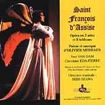
Saint Francois d'Assise Christiane Eda-Pierre, soprano (Angel); Jose van Dam, baritone (St. Francis); Kenneth Riegel, tenor (Leper); Michel Philippe, baritone (Brother Leon); Georges Gauthier, tenor (Brother Massee); Michel Sénéchal, tenor (Brother Élie); Jean-Philippe Courtis, bass (Brother Bernard); Paris National Opera Chorus & Orchestra; Seiji Ozawa, conductor (Cybellia)
It seems inevitable that a composer so focused on Catholicism and birdsongs would come to treat the story of St. Francis of Assisi, patron saint of animals, whose legend says that he conversed with animals and preached to birds, who did not fly away when he approached them. That Messiaen, who wrote the libretto as well as the music, would do so in the form of an opera was a surprise, but even though he composed this piece (from 1975 to 1983) to fulfill a commission from the Paris Opera, he was uncomfortable calling it an opera, and it is more of an oratorio, or a collection of tableaux: Act I, Scene 1: La Croix [The Cross] Francis explains that "perfect joy" comes through enduring suffering. Act I, Scene 2: Les Laudes [The Praises] Following Matins, Francis, alone, prays to God to grant to him the ability to meet and love a leper. Act I, Scene 3: Le baiser au l'apreux [The Kissing of the Leper] Francis gets his wish. The leper is cured after Francis embraces him. Act II, Scene 4: L'ange voyager [The Traveling Angel] An angel disguised as a traveler knocks at the monastery door and asks Brother Elias about Predistination; he refuses to answer and closes the door. The angel knocks again, and Brother Bernardo answers his question.
Afterward the Brothers wonder whether the questioner was an angel. Act II, Scene 5: L'ange musicien [The Angel of Music] The angel plays his viol to give Francis an idea of heavenly bliss. Act II, Scene 6: Le preche aux oiseaux [The Preaching to the Birds] Francis preaches to and blesses a treeful of birds. The birds answer with a mighty chorus of many songs. Act III, Scene 7: Les stigmates [The Stigmata] Francis receives the five stigmata. Act III, Scene 8: La mort et la nouvelle vie [The Death and the New Life] Francis dies and the choir sings of resurrection. Taken from two December 1983 concerts the week after the premiere with the same forces, this remains my favorite (not that there's much competition). It's a four-CD set, lasting nearly four hours; supposedly it can be special-ordered on arkivmusic.com. Alternatively, Kent Nagano's version on Deutsche Grammophon (1998), also with van Dam but with Dawn Upshaw as the Angel, is a fine substitute (as is so often true in opera, with so many facets to be considered, each version is superior in some aspects and inferior in others). Orfeo d'Or has released a 1985 Salzburg Festival production conducted by Lothar Zagrosek, with Dietrich Fischer-Dieskau in the title role, but that contains only half the scenes.
